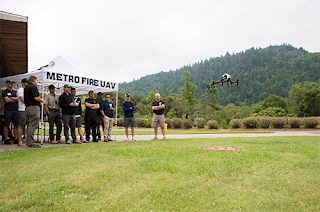ALPINE COUNTY, CA (KOLO) Alpine County sits in a rugged
corner of the Eastern Sierra just south of Lake Tahoe, barely 11 hundred
residents and nearly 750 square miles of mountain and forest.
But it gets a lot of visitors, campers, hikers, kayakers,
people just passing through. From time to time some get into trouble.
First responders are the small staff of the Alpine County
Sheriff's Office and their search and rescue volunteers. Not a lot of manpower,
but they have a powerful tool, the sheriff office's drone.
Their drone is equipped with camera and heat imaging,
able to search from the air when those below can't.
"We use it during the hasty search period when we
don't have other manned aircraft in the air space," says Deputy Sheriff
Jake Krzaczek, "and we can also use it to search at night, which
previously we were reluctant to do because it puts our volunteers in harm's
way."
With the heat imaging camera, the drone operator can identify
by sight and by body temperature whether he's found a lost hiker or a bear,
deer or steer.
And once found and identified, the drone can carry a life
saving payload.
"We can drop medical supplies. We can drop them
food, water, a radio, extra clothing, anything they might need to keep them
alive until we can get bodies on scene to get them out of from where they're
at."
The sheriff's department and its volunteers keep finding
new ways to use the drone. The latest stemmed from an incident involving a
person trapped on the far side of a raging river. Standard procedure would be
to throw them a rescue bag attached to a line.
"We finally had to put a rock in the bag itself to
give it some weight to throw it and finally got it to him," recalls
Krzaczek. "And I think everyone's shoulder hurt a little bit, so we
thought, how can we make this easier? We had the payload capability in the
drone and we did a dry run in the parking lot one day and thought this could
work."
And so, a new use for the drone was developed. Now
Krzaczek and his volunteers work it into their training routine. The exercise
we witnessed was on a relatively placid spot on he west fork of the Carson
River. Elsewhere the county's streams were what he described as
"hairy."
"There's areas on the west fork and the east fork
that are ripping right now where I wouldn't want to put my guys in the water if
I didn't have to."
So imagine a kayaker or fisherman fallen into the icy
water in the midst of rapids, either floating or clinging to a rock.
The drone drops the rescue line to him without
endangering the volunteer.
So you can add swift water rescue to that growing list of
uses for drones and that's not likely to be the end of it."
"It's incredible," says Krzaczek. "There's
going to be so many uses for them in the next few years."





